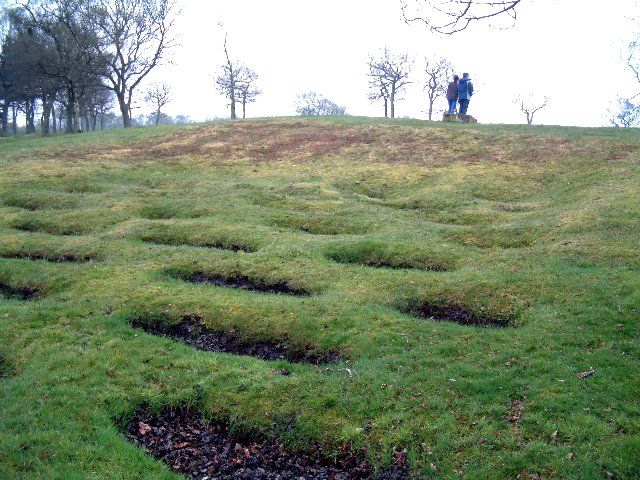|
Lilia
Lilia (Latin plural, meaning "lilies" in English; singular, ''lilium'') are pit traps arranged in a quincunx A quincunx () is a geometric pattern consisting of five points arranged in a cross, with four of them forming a square or rectangle and a fifth at its center. The same pattern has other names, including "in saltire" or "in cross" in heraldry (d ... pattern dug by the Roman armies in front of their defences. Frequently they had sharpened stakes set inside them as an extra obstacle to attackers. Lilia have been found in front of both Hadrian's Wall in England and the Antonine Wall in Scotland. External links Images of lilies at the Antonine Wall Fortification (obstacles) {{Fort-stub ... [...More Info...] [...Related Items...] OR: [Wikipedia] [Google] [Baidu] |
Rough Castle Fort
Rough Castle Fort is a Roman fort on the Antonine Wall roughly 2 kilometres south east of Bonnybridge near Tamfourhill in the Falkirk council area, Scotland. It is owned by the National Trust for Scotland. Context The Antonine Wall dates from about 143 AD. The ends of the wall were uncertain for many years. In the east Carriden near Bo'ness on the Forth was a likely endpoint. In the west is Old Kilpatrick on the Clyde, although there were also forts beyond that at Bishopton and Barochan Hill. The fort is one of the best-preserved of the forts constructed along the Wall. Built against the southern rear face of the Wall, the fort was defended by 6 metre thick turf ramparts and surrounded by defensive ditches. Gateways were provided through the main wall to the north, and also through the walls on the other three sides of the fort. Causeways were then constructed across the main Antonine and secondary defensive ditches, affording easy access to and from the fort. The fort was th ... [...More Info...] [...Related Items...] OR: [Wikipedia] [Google] [Baidu] |
Quincunx
A quincunx () is a geometric pattern consisting of five points arranged in a cross, with four of them forming a square or rectangle and a fifth at its center. The same pattern has other names, including "in saltire" or "in cross" in heraldry (depending on the orientation of the outer square), the five-point stencil in numerical analysis, and the five dots tattoo. It forms the arrangement of five units in the pattern corresponding to the five-spot on six-sided dice, playing cards, and dominoes. It is represented in Unicode as or (for the die pattern) . Historical origins of the name The quincunx was originally a coin issued by the Roman Republic c. 211–200 BC, whose value was five twelfths (''quinque'' and ''uncia'') of an as, the Roman standard bronze coin. On the Roman quincunx coins, the value was sometimes indicated by a pattern of five dots or pellets. However, these dots were not always arranged in a quincunx pattern. The ''Oxford English Dictionary'' (OED) d ... [...More Info...] [...Related Items...] OR: [Wikipedia] [Google] [Baidu] |
Hadrian's Wall
Hadrian's Wall ( la, Vallum Aelium), also known as the Roman Wall, Picts' Wall, or ''Vallum Hadriani'' in Latin, is a former defensive fortification of the Roman province of Britannia, begun in AD 122 in the reign of the Emperor Hadrian. Running from Wallsend on the River Tyne in the east to Bowness-on-Solway in the west of what is now northern England, it was a stone wall with large ditches in front of it and behind it that crossed the whole width of the island. Soldiers were garrisoned along the line of the wall in large forts, smaller milecastles and intervening turrets. In addition to the wall's defensive military role, its gates may have been customs posts. A significant portion of the wall still stands and can be followed on foot along the adjoining Hadrian's Wall Path. The largest Roman archaeological feature in Britain, it runs a total of in northern England. Regarded as a British cultural icon, Hadrian's Wall is one of Britain's major ancient tourist attract ... [...More Info...] [...Related Items...] OR: [Wikipedia] [Google] [Baidu] |
Antonine Wall
The Antonine Wall, known to the Romans as ''Vallum Antonini'', was a turf fortification on stone foundations, built by the Romans across what is now the Central Belt of Scotland, between the Firth of Clyde and the Firth of Forth. Built some twenty years after Hadrian's Wall to the south, and intended to supersede it, while it was garrisoned it was the northernmost frontier barrier of the Roman Empire. It spanned approximately and was about high and wide. Lidar scans have been carried out to establish the length of the wall and the Roman distance units used. Security was bolstered by a deep ditch on the northern side. It is thought that there was a wooden palisade on top of the turf. The barrier was the second of two "great walls" created by the Romans in Great Britain in the second century AD. Its ruins are less evident than those of the better-known and longer Hadrian's Wall to the south, primarily because the turf and wood wall has largely weathered away, unlike its stone-bu ... [...More Info...] [...Related Items...] OR: [Wikipedia] [Google] [Baidu] |




